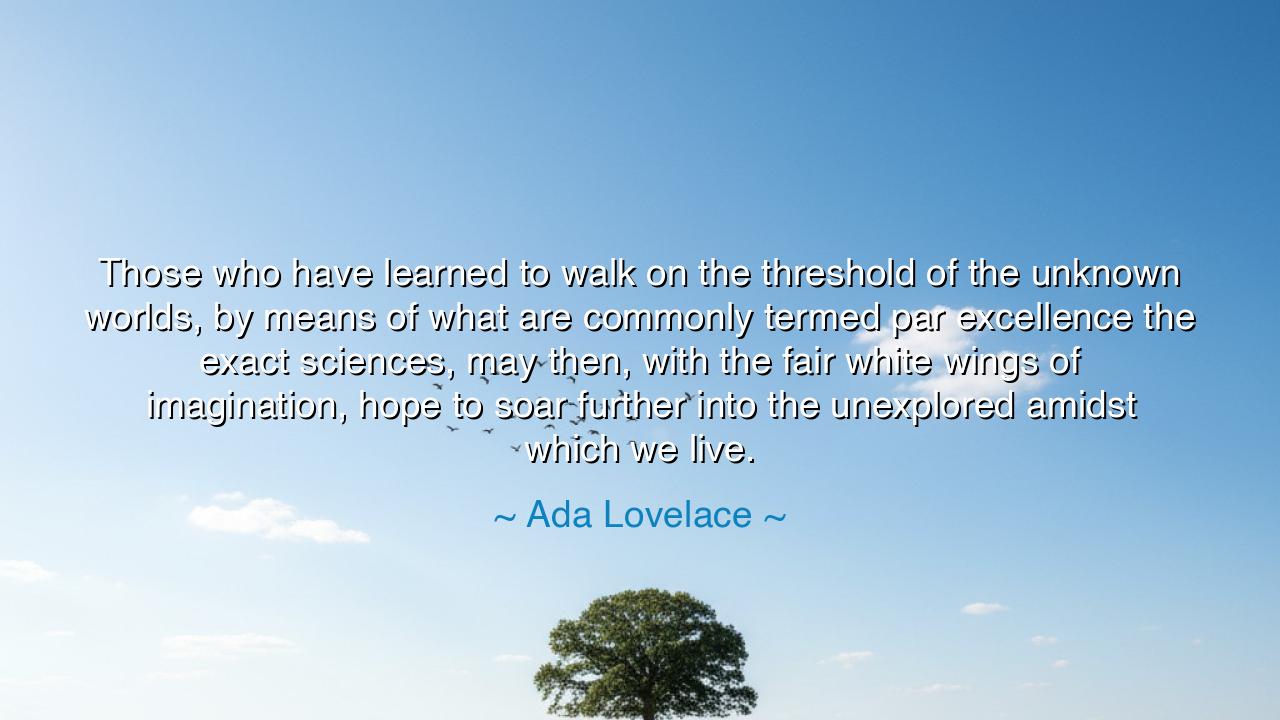
Those who have learned to walk on the threshold of the unknown
Those who have learned to walk on the threshold of the unknown worlds, by means of what are commonly termed par excellence the exact sciences, may then, with the fair white wings of imagination, hope to soar further into the unexplored amidst which we live.






Hearken, O children of reason and vision, and lend your ears to the words of Ada Lovelace, the prophetess of computation, who declared: “Those who have learned to walk on the threshold of the unknown worlds, by means of what are commonly termed par excellence the exact sciences, may then, with the fair white wings of imagination, hope to soar further into the unexplored amidst which we live.” In these words lies a meditation upon the union of knowledge and imagination, the sacred marriage of discipline and creativity, and the path by which humanity may ascend beyond the familiar into realms yet uncharted.
Since the dawn of human inquiry, mortals have sought to pierce the veil of the unknown. The astronomers of ancient Babylon charted stars, the mathematicians of Alexandria measured the cosmos, and the philosophers of Athens traced the limits of reason. Lovelace speaks to this eternal quest: the exact sciences—mathematics, mechanics, astronomy—are not mere tools of calculation, but keys that unlock doors to worlds unseen, thresholds that must be walked with diligence and curiosity before imagination may take flight.
Consider the life of Leonardo da Vinci, whose sketches of flying machines, anatomical studies, and engineering marvels reveal a mind both disciplined and visionary. He mastered observation, measurement, and calculation—the exact sciences of his time—yet he did not remain bound to them. With the wings of imagination, he soared into ideas centuries ahead of his age, envisioning innovations that only much later became reality. Lovelace’s vision mirrors this path: mastery of the known empowers exploration of the unknown.
The essence of this teaching lies in balance. Knowledge alone, untempered by creativity, risks stagnation; imagination alone, unmoored from discipline, drifts aimlessly. Those who learn to walk on the threshold of unknown worlds combine the rigor of science with the courage of imagination, allowing insight to rise above mere observation into vision, speculation, and innovation. In this interplay, the soul discovers both freedom and power.
History provides further illustration. When Ada Lovelace herself interpreted Charles Babbage’s Analytical Engine, she did not merely describe its functions. She imagined its potential, conceiving of algorithms capable of producing music, graphics, and computation beyond simple arithmetic. By combining mastery of mathematics with the fair white wings of imagination, she glimpsed a future that would not arrive for over a century. Here, discipline enabled creativity to soar.
O seeker, take this teaching into your own life: pursue knowledge with rigor, cultivate your understanding of the sciences, mathematics, and principles that structure the world. But let this learning be a foundation, not a cage. Allow imagination, curiosity, and vision to lift you beyond the ordinary, to explore the unexplored realms of thought, innovation, and creation. Knowledge becomes wings when paired with vision, and vision finds direction in knowledge.
Moreover, understand that courage is inseparable from insight. Walking the threshold of the unknown requires humility and daring, acknowledging the limits of what is known while daring to envision what is possible. The pioneers of science, art, and philosophy—Galileo, Curie, Da Vinci, Lovelace herself—taught that exploration demands both mastery and audacity. Discipline opens the gate; imagination carries us beyond it.
Thus, Ada Lovelace’s words endure as both meditation and instruction: master the sciences, walk deliberately at the edge of the unknown, and let imagination lift you further into unexplored realms. In this harmony lies the path of discovery, innovation, and human greatness. Let every study, calculation, and observation serve as preparation for flights of thought that transcend the present, shaping the world not only as it is, but as it might be.
If you wish, I can also craft a short illustrative story showing a modern thinker or inventor using science and imagination to explore new frontiers, making Lovelace’s vision vividly tangible for listeners. Would you like me to do that?






AAdministratorAdministrator
Welcome, honored guests. Please leave a comment, we will respond soon